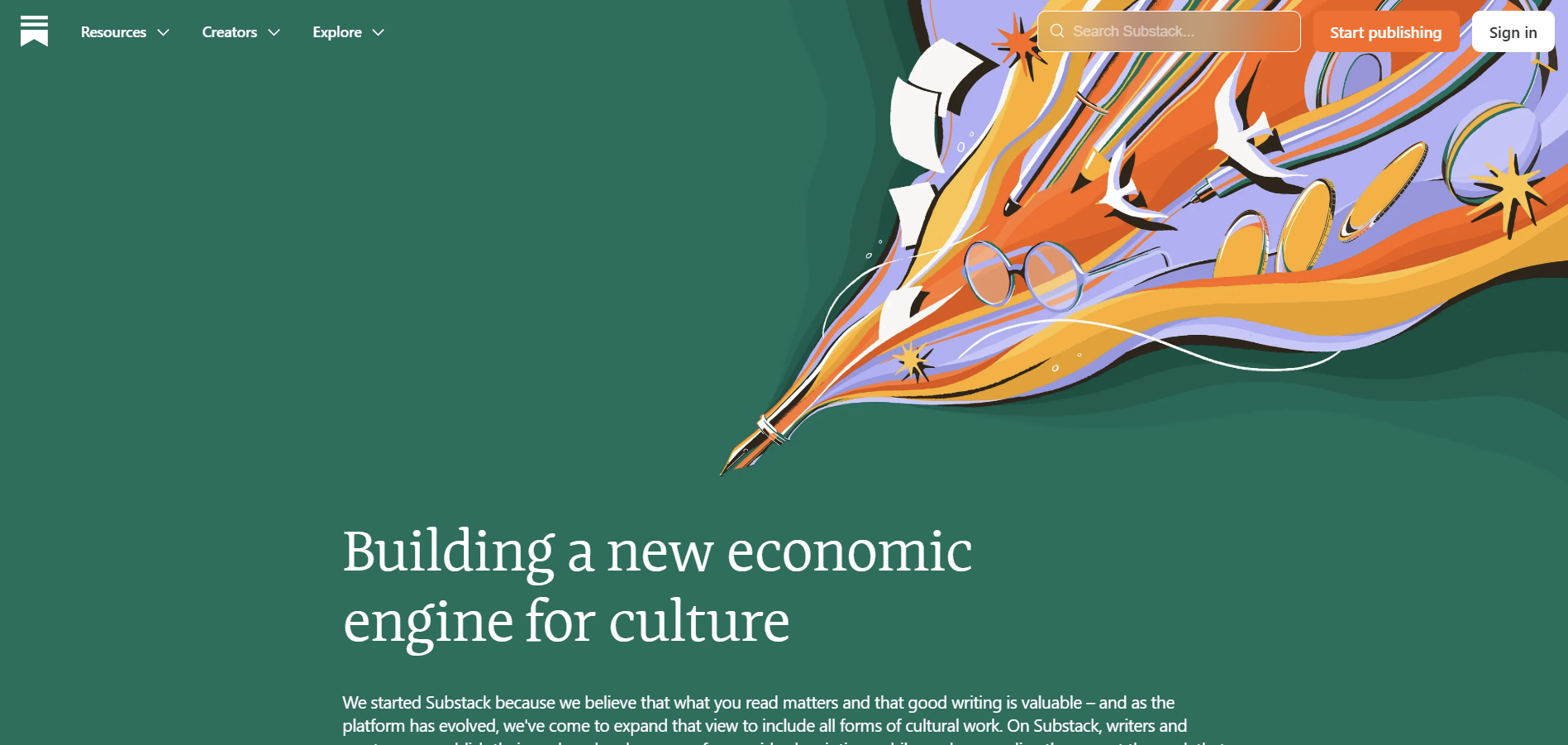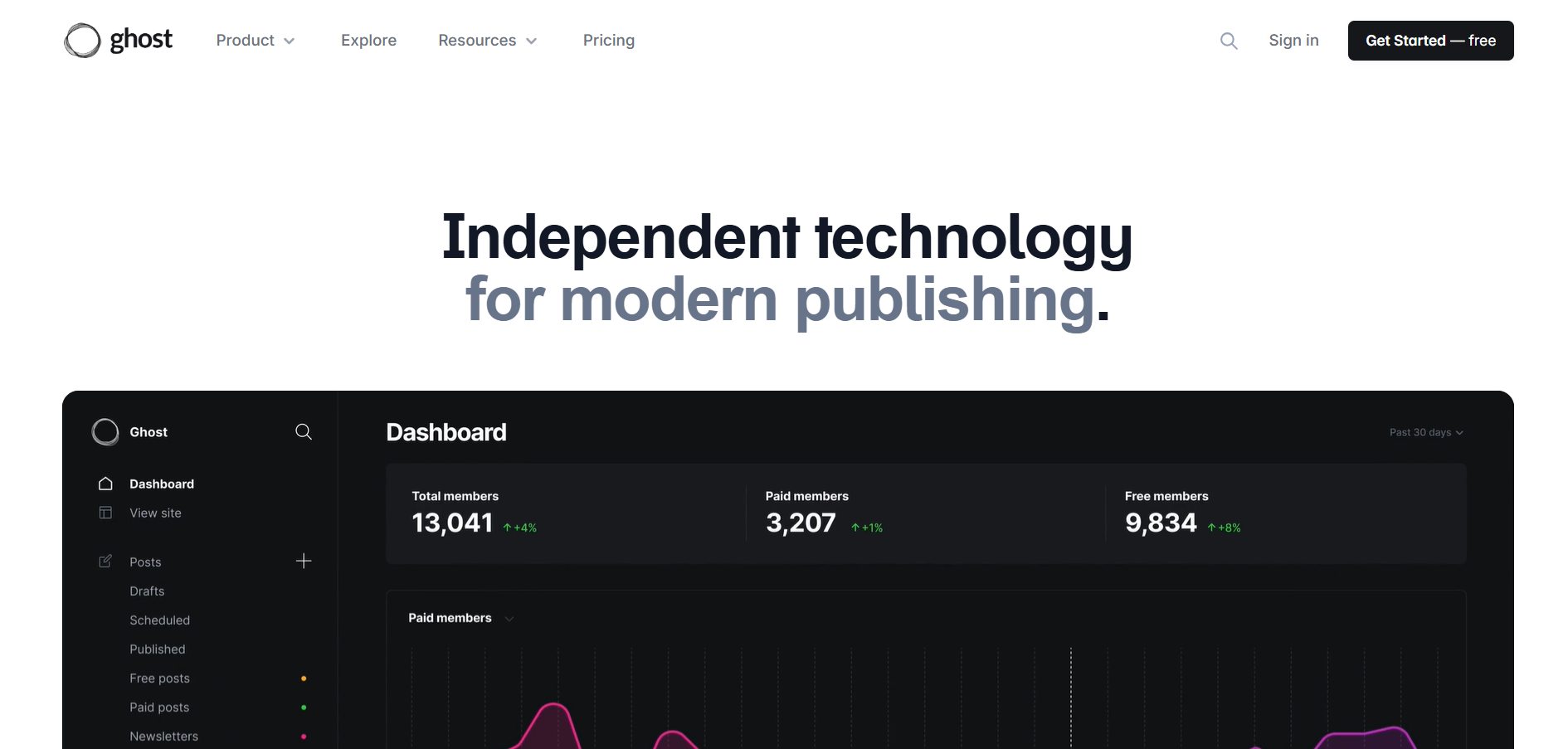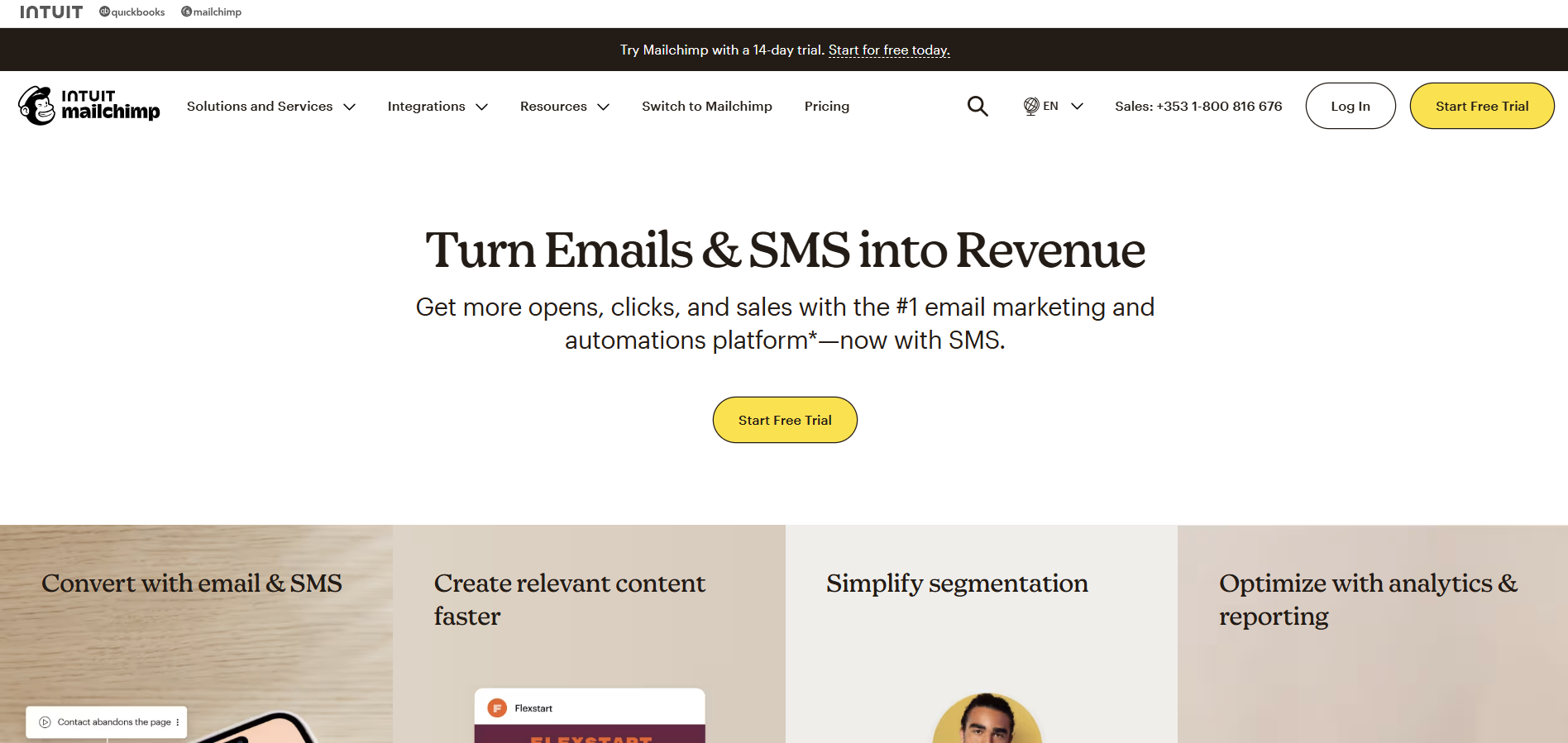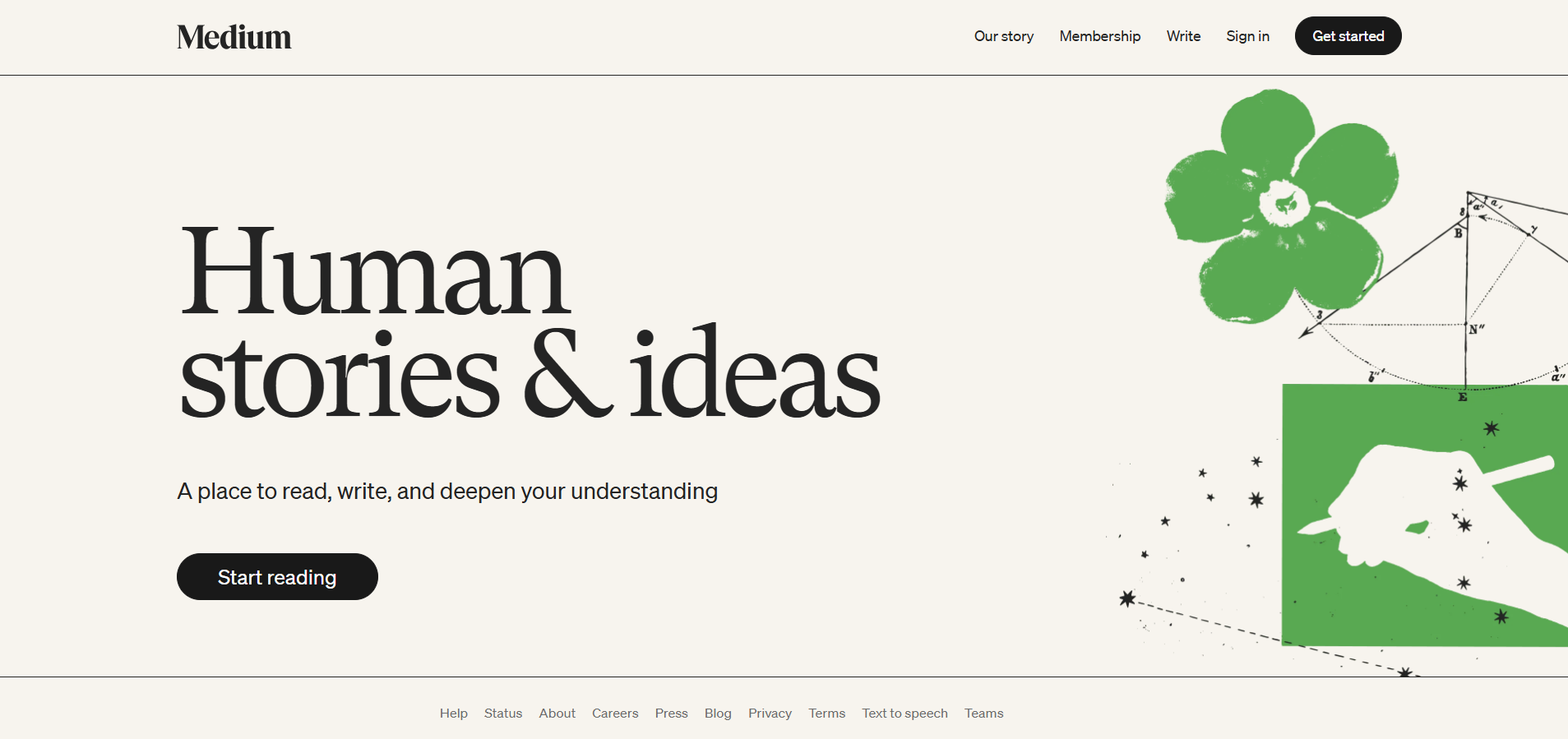Top Substack Alternatives for Newsletter Publishing in 2025
Written by: Hrishikesh Pardeshi, Founder at Flexiple, buildd & Remote Tools.
Last updated: Feb 28, 2025

Best Substack alternatives in 2025 are:
Ghost
Revue (by Twitter)
ConvertKit
Mailchimp
Medium
Patreon
In today’s rapidly evolving digital publishing landscape, finding the right alternative to Substack is essential for creators, writers, and publishers looking for flexibility, enhanced monetization, and diverse feature sets. Whether you're seeking a blogging and writing platform that offers a robust content management system, advanced email marketing capabilities to track email marketing campaigns, or integrated community tools, the alternatives listed below provide a range of options tailored to different needs. This guide explores the top Substack alternatives, comparing their features, pros, cons, and pricing to help you make an informed decision. These options include not only comprehensive newsletter and website platforms but also simpler solutions that require just an email address to get started.
Table of Contents
Why Do You Need Alternatives to Substack?
Alternatives to Substack are essential for creators seeking more control and enhanced features. While Substack is a popular platform, its one-size-fits-all approach may not cater to every creator’s unique needs.
Key Reasons to Consider Alternatives:
Comprehensive Publishing Tools: Other platforms often provide advanced formatting options, scheduling, and multimedia support that can elevate your content.
Enhanced Customization: Tailor your site’s look and functionality to better reflect your brand and meet your audience’s expectations.
Integrated Marketing Features: Benefit from built-in analytics, SEO tools, and community management features that can help you grow and engage your audience more effectively.
Better Revenue Control: Alternative pricing models and monetization strategies can offer more flexibility, allowing you to optimize your revenue streams.
Who Should Consider Using Substack Alternatives?
Substack alternatives are essential for creators who need platforms tailored to their unique digital publishing requirements. Whether you’re a seasoned writer, an independent journalist, a podcaster, or a multimedia storyteller, exploring alternatives can unlock features that better align with your creative vision and monetization strategy. These platforms often offer just a hosted version, along with options for paid subscriptions the platform. They also provide education and training materials to help creators maximize their reach and efficiency, as well as capabilities to publish members-only content to engage with their audience more intimately.
Creators Seeking Customization and Control
Platforms like Ghost offer extensive customization options and robust content management capabilities, ideal for creators who want to maintain complete control over their branding and site functionality. With its membership management software, Ghost also caters to the needs of paying subscribers, ensuring a smooth and personalized user experience.
Ghost's streamlined development process and built-in SEO tools empower creators to deliver fast, secure, and highly optimized websites. Its flexible theming and integration with modern development frameworks ensure that every site can be tailored to reflect a unique brand identity, while its user-friendly interface simplifies content creation and ongoing management.
Writers Focused on Integrated Email Marketing
For writers who depend on direct communication with their readers, alternatives such as ConvertKit and Mailchimp provide built-in email marketing tools and subscriber management features that enhance audience engagement.
These platforms offer automation workflows, advanced analytics, and customizable templates that enable writers to segment their audiences and schedule targeted campaigns. This integrated approach not only streamlines communication but also allows writers to fine-tune their strategies based on engagement data, fostering a more loyal and active readership.
Publishers Looking for Community and Collaboration Features
If community building and interactive features are your priorities, Medium and Patreon provide powerful tools for content curation, social engagement, and subscriber monetization.
These platforms not only help creators reach and engage wider audiences but also offer detailed analytics and feedback mechanisms that enable continuous improvement. They allow for the creation of tiered membership systems, exclusive content releases, and interactive discussions, ensuring that community members feel valued and connected while creators can effectively monetize their efforts.
Creators Interested in Simplicity and Ease of Use
For those who prefer a straightforward, user-friendly interface, Revue (by Twitter) delivers a streamlined experience with essential publishing tools integrated into a familiar social media environment.
Revue’s seamless integration with Twitter enhances content discoverability and engagement by allowing users to effortlessly share their newsletters and tap into a vast, active audience. Its intuitive analytics and monetization features further empower creators to fine-tune their content strategy, ensuring they can focus on quality storytelling while effectively growing their readership.
Substack Alternatives Comparison Table
| Feature | Ghost | Revue (by Twitter) | ConvertKit | Mailchimp | Medium | Patreon |
|---|---|---|---|---|---|---|
| Ease of Use | Moderate | Easy | Easy | Easy | Very Easy | Moderate |
| Pricing | Paid Plans | Free & Paid | Paid Plans | Free & Paid Plans | Free with Premium Membership | Subscription-Based |
| Platform Support | Self-hosted/Cloud | Browser-based | Browser-based | Browser-based | Browser-based | Browser-based |
| Collaboration Features | Moderate | Basic | Extensive | Extensive | Social Sharing | Community Tools |
| Special Features | Full CMS & Customization | Integrated with Twitter | Email Automation | Marketing Automation | Curated Content Network | Membership Monetization |
Best Substack Alternatives
Choosing the right alternative to Substack can empower you to publish content with greater flexibility and enhanced monetization options. The following platforms offer a diverse range of features, from advanced customization and integrated email marketing to community engagement and subscriber monetization. Below is a detailed overview of the top Substack alternatives to consider for your digital publishing needs in 2025.
1. Ghost

Ghost is a powerful, open-source publishing platform that provides creators with full control over their content and design. It offers a robust content management system combined with built-in SEO and membership features, making it ideal for writers and publishers who want a highly customizable and self-hosted solution.
Ghost’s modular architecture and active developer community foster a vibrant ecosystem of themes, integrations, and plugins that extend its functionality. Its performance-optimized framework ensures fast load times and a seamless user experience, which is essential for engaging audiences and enhancing search rankings. This dynamic environment empowers creators to continuously innovate and tailor their digital presence as their needs evolve.
Ghost vs Substack
Ghost offers extensive customization and control over your site’s appearance and functionality, which can be a significant advantage over Substack. While Substack focuses on simplicity and ease of use, Ghost provides a richer feature set for advanced publishers.
Key Features of Ghost
Fully customizable themes and design
Robust content management system (CMS)
Built-in SEO and membership tools
Support for subscriptions and memberships
Open-source flexibility for self-hosting
Ghost Pros
Highly customizable and developer-friendly
Strong focus on performance and SEO
Integrated membership and subscription options
Active community and extensive documentation
Ghost Cons
Requires more technical expertise for setup and customization
No native integrated email marketing features
Higher cost for managed hosting compared to simple platforms
Ghost Pricing
Ghost offers three pricing plans for its content management platform. The Basic plan starts at $29 per month, providing essential features for professional publishers just getting started. The Standard plan, priced at $79 per month, offers everything needed to manage a growing publication, including 500,000 monthly page views and 5 staff users.
For serious publishers requiring more power and guaranteed uptime, the Business plan is available at $199 per month. Ghost provides a 14-day free trial for all plans, allowing users to set up their site and choose a plan later.
2. ConvertKit

ConvertKit is an email marketing platform tailored for creators who want to build and nurture an audience. It combines powerful email automation with landing pages and forms, making it a great alternative for those who want integrated email marketing alongside their content.
ConvertKit vs Substack
ConvertKit stands out by offering a robust suite of email marketing tools, which can be invaluable for creators looking to manage their subscriber lists and run automated campaigns. Unlike Substack, ConvertKit focuses heavily on email automation and audience engagement.
ConvertKit's intuitive interface and seamless integrations with other creative and analytics tools empower users to design, segment, and optimize campaigns effectively. Its comprehensive analytics provide insights into subscriber behavior and campaign performance, allowing creators to refine their messaging and build deeper, more meaningful connections with their audience.
Key Features of ConvertKit
Advanced email automation workflows
Integrated landing pages and forms
Subscriber segmentation and tagging
Easy-to-use visual automation builder
Robust reporting and analytics
ConvertKit Pros
Comprehensive email marketing and automation
User-friendly interface with drag-and-drop tools
Effective subscriber segmentation
Great for nurturing and growing an audience
ConvertKit Cons
Higher pricing for advanced features
Limited design customization for newsletters
May require a learning curve for beginners
ConvertKit Pricing
ConvertKit offers three main pricing tiers: Free, Creator, and Creator Pro. The Free plan allows users to manage up to 1,000 subscribers at no cost. The Creator plan starts at $29 per month for up to 1,000 subscribers, with pricing increasing based on subscriber count. For instance, it costs $119 per month for 10,000 subscribers and $379 per month for 55,000 subscribers.
The Creator Pro plan, designed for advanced users, starts at $59 per month for up to 1,000 subscribers and scales up to $519 per month for 55,000 subscribers. ConvertKit's pricing is structured to grow with the size of the user's audience, offering more advanced features and capabilities at higher tiers.
3. Mailchimp

Mailchimp is a well-known marketing platform that offers robust email marketing tools along with landing pages, CRM integrations, and analytics. It serves as a versatile alternative for creators looking to combine content publishing with comprehensive marketing campaigns.
Mailchimp vs Substack
Mailchimp provides a broader range of marketing and automation tools compared to Substack. While Substack focuses on newsletter publishing, Mailchimp integrates email marketing with in-depth analytics and campaign management, making it ideal for creators who want to scale their marketing efforts.
Mailchimp's robust automation features and deep integrations with various digital platforms enable creators to execute multichannel campaigns effortlessly. Its advanced segmentation and personalized customer journey tools allow for tailored messaging that resonates with diverse audience segments, driving higher engagement and conversion rates. With comprehensive real-time analytics and reporting, Mailchimp empowers users to continually refine their strategies, ensuring a competitive edge in today's dynamic digital landscape.
Key Features of Mailchimp
Comprehensive email marketing tools
Landing pages and audience segmentation
Integrated CRM and automation workflows
Detailed reporting and analytics
Drag-and-drop email editor
Mailchimp Pros
Powerful automation and integration features
Wide range of templates and customization options
Strong reporting and audience analytics
Extensive third-party integrations
Mailchimp Cons
Can be overwhelming for beginners
Higher pricing tiers for advanced features
Complex interface compared to simpler tools
Mailchimp Pricing
Mailchimp's pricing structure consists of four main plans: Free, Essentials, Standard, and Premium. The Free plan allows up to 500 contacts and 1,000 monthly email sends. The Essentials plan starts at $13 per month for up to 500 contacts, offering 5,000 monthly email sends.
The Standard plan begins at $20 per month for 500 contacts, providing 6,000 monthly email sends and scaling up to $800 per month for 100,000 contacts. The Premium plan starts at $350 per month for 10,000 contacts and goes up to $1,600 per month for 200,000 contacts, offering advanced features and priority support. Mailchimp's pricing is primarily based on the number of contacts and email send volume, with additional costs for exceeding limits or adding extra features.
4. Medium

Medium is a popular online publishing platform known for its clean design and built-in audience. It’s ideal for writers who want to focus solely on content creation without worrying about site maintenance or technical details.
Medium vs Substack
Medium provides a frictionless publishing experience with access to a large, engaged community. However, while Substack emphasizes subscription monetization, Medium focuses on content discovery and reader engagement, with monetization primarily through its partner program.
Medium’s robust engagement tools—such as in-line highlighting, commenting, and sharing features—create a dynamic ecosystem that encourages direct interaction between writers and readers. This community-driven approach not only helps authors refine their content based on real-time feedback but also promotes organic growth through content recommendations, ultimately fostering a more enriching and sustained connection with audiences.
Key Features of Medium
Elegant and minimalist writing interface
Built-in audience and content discovery
Easy social sharing and engagement tools
Partner program for monetization
Responsive design across devices
Medium Pros
User-friendly and visually appealing interface
Access to a large readership
No technical setup or maintenance required
Ideal for storytelling and thought leadership
Medium Cons
Limited control over monetization and branding
Less customization for layout and design
Dependence on Medium’s platform policies
Medium Pricing
Medium offers several pricing options for its membership. The monthly subscription is priced at $4.99, while the annual subscription costs $49.99, providing a slight discount for those who commit to a full year. For those preferring a more flexible approach, Medium also offers a monthly membership at $5 and an annual membership at $60.
Additionally, Medium provides a "Friend of Medium" tier, which is priced at $15 monthly or $150 annually, offering enhanced benefits for dedicated supporters. These subscriptions grant users unlimited access to Medium's vast library of articles, audio versions of stories, and the ability to support writers directly through the platform's Partner Program.
5. Patreon

Patreon is a membership platform that enables creators to earn recurring revenue by offering exclusive content to their subscribers. It is ideal for creators looking to build a sustainable income stream through fan support and community engagement.
Patreon vs Substack
Patreon shifts the focus from one-time newsletter subscriptions to building a community of dedicated patrons. While Substack is centered on email newsletters, Patreon provides extensive membership tools, offering creators multiple ways to monetize their work through tiers and exclusive content.
Patreon cultivates a deeper connection between creators and their audiences by integrating interactive features such as live chats, exclusive member forums, and behind-the-scenes content. This community-centric approach not only drives recurring revenue but also empowers creators to gather valuable feedback and refine their offerings, ensuring a sustainable and engaging ecosystem for long-term creative growth.
Key Features of Patreon
Membership and subscription management
Tiered pricing for exclusive content
Integrated community engagement tools
Analytics and performance tracking
Flexible reward and benefit options
Patreon Pros
Robust membership and monetization features
Strong community-building tools
Multiple revenue streams through tiered offerings
Support for a wide variety of content types
Patreon Cons
Platform fees can reduce overall revenue
Requires ongoing engagement to retain patrons
Less focused on email publishing
Potentially high competition among creators
Patreon Pricing
Patreon's pricing structure is more variable, as it depends on the individual creator's tiers and the plan they choose. Patreon itself offers three main plans for creators: Pro, Premium, and Commerce. The Pro plan takes 8% of the income earned on Patreon, while the Premium plan takes 12%, both in addition to payment processing fees. The Commerce plan, designed for selling individual digital products, charges 5% of monthly sales earnings plus associated fees.
For patrons, prices can vary widely based on the creator's offerings. Some creators have recently announced price increases, such as one who will raise their tiers to range from $8 to $30 monthly starting August 1, 2025, for new patrons only. Another creator has set a new minimum subscription rate of $15 per month starting January 2025. It's important to note that many creators are maintaining lower rates for existing patrons as a loyalty benefit.
FAQs on Substack Alternatives
1. What are the top alternatives to Substack?
The top alternatives to Substack include Ghost, Revue (by Twitter), ConvertKit, Mailchimp, Medium, and Patreon. These platforms offer diverse features for digital publishing, email marketing, and community monetization, catering to various needs of creators and publishers.
2. Why should I consider using an alternative to Substack?
You should consider using an alternative to Substack if you require more customization, advanced email marketing tools, integrated community features, or a different monetization model. Each alternative offers unique benefits that can help you tailor your publishing strategy to better engage with your audience and maximize revenue.
3. Are Substack alternatives free to use?
Many Substack alternatives offer free plans or free access to basic features. For example, Medium allows free publishing with monetization through its partner program, while Revue offers both free and paid plans. Other platforms, such as Ghost (self-hosted) and ConvertKit, are based on paid subscriptions, though they often offer trial periods.
4. Which Substack alternative is best for email marketing?
For creators focused on email marketing, ConvertKit and Mailchimp are excellent choices. They provide robust automation, segmentation, and campaign management features that help you build and nurture your subscriber base effectively.
5. Can I monetize my content effectively with these alternatives?
Yes, each alternative offers different monetization models. Ghost and ConvertKit support subscription-based revenue, Medium offers a partner program for monetization, and Patreon provides a membership-based revenue stream. Your choice should align with your content strategy and audience engagement goals.